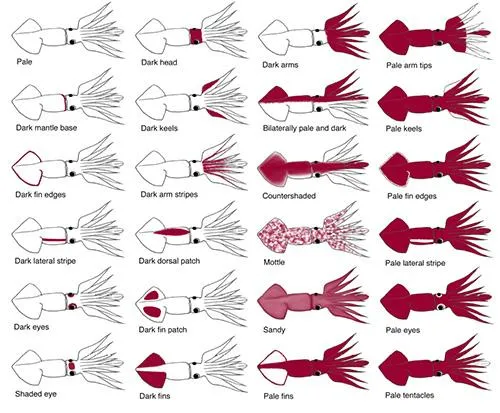Deep-Sea Squids Glow to Communicate in the Dark
Researchers suggest that the Humboldt squid uses bioluminescent backlighting for visual cues in the dark deep sea
/https://tf-cmsv2-smithsonianmag-media.s3.amazonaws.com/filer/5c/9e/5c9ee0ac-3f1f-4ded-8e29-6a792a17cd31/dosidiscus_gigas-swarm-v3516_.jpg)
The deep sea is vast, empty and dark—not an ideal place for animals to communicate via visual signals. Yet the Humboldt squid (Dosidicus giga), a social species that lives in groups of hundreds of individuals, can communicate visually at depths of 600 feet or more.
Cephalopods including squid, octopus and cuttlefish are known for a stunning array of visual displays. These marine creatures possess pigment cells called chromatophores surrounded by muscles that expand and contract, allowing for a wide variety of colorful patterns. While researchers understood these abilities, a question remained regarding just how deep-sea cephalopods might make these displays visible in their dark, deep environment.
New research by Ben Burford of Stanford University and Bruce Robison of the Monterey Bay Aquarium Research Institute (MBARI) suggests that the Humboldt squid uses bioluminescent light organs known as photophores to backlight their visual displays. Much like an e-reader that layers text over a lighting layer, the Humboldt squid layers chromatophores on top of photophores to make their displays easier to see in the dark. (The Humboldt squid, and the current of the same name it is native to, is named after Alexander von Humboldt, an influential naturalist and the subject of a forthcoming exhibit at the Smithsonian American Art Museum.)
/https://tf-cmsv2-smithsonianmag-media.s3.amazonaws.com/filer/81/14/81148d5b-1aa2-4265-987f-8555151f9e3b/dosidicus-group-v3461-3.jpg)
Many deep-sea creatures use bioluminescence for defense, camouflage and predatory behaviors. One famous example is the anglerfish and its luminescent lure. Some creatures present bioluminescent displays that are sex- and species-specific, allowing them to identify others within their species and gender. Lead author Burford found that the Humboldt squid’s use of bioluminescence is unique.
“Humboldt squids have small aggregations of luminescent tissue—little dots sprinkled throughout their muscles,” Burford says. “Instead of projecting light outwards, what these photophores do is radiate light within the body tissue. They make the whole animal glow.”
The research team looked to link behaviors associated with chromatophores to places on the squid’s body where the photophores congregate. “They have some subtle behaviors, like a darkened edge of their fins, dark strips along their arms, or a dark spot between their eyes on the top of their head,” Burford said. “If those behaviors are subtle then maybe to boost their visibility their photophores are aggregated.” This is what was observed in some cases: Denser clusters of photophores under parts of the squid’s skin corresponded with these subtle behaviors. Based on the evidence that the photophores were not evenly distributed throughout the body, Burford and Robison believe that behaviors and the concentrations are linked.
Using remotely operated vehicles (ROVs), the research team observed the squid in action, watching as groups of these four-foot-tall creatures foraged in the deep sea. As this group of Humboldt squids pursued their prey, they displayed a behavior called “flickering” across their bodies. Humboldt squids are aggressive predators, and because they live in groups, the chase can become frenzied. Yet the researchers noted that the large squids appeared to be somewhat coordinated during the chase, never bumping into each other and rarely competing for the same prey. This suggests that the flickering behavior and other visual cues allow for cooperative hunting.
“It’s like turn signaling in traffic,” Burford says. “Driving is dangerous, being a Humboldt squid in a group is dangerous and you’ve got to signal to tell people what you’re going to do and that they shouldn't mess with you while you’re doing it.”
Flickering has been seen in shallow-water studies of this species when the squids are spawning. The fact that such behavior is seen in group dynamics suggests to scientists that these social squids may be using it and other behaviors for specific purposes.

The deep sea is the largest habitat on Earth, and these types of discoveries demonstrate still more exciting discoveries are yet to come. For example, researchers had previously identified 28 pigmentation patterns in the Humboldt squid. Burford and Robison have been working to contextualize the meanings of each.
“We found that it’s possible that those 28 elements of their repertoire have specific meanings,” Burford says. “But it seems like they can combine them in different ways and those combinations could also have meanings. And that should sound familiar because it’s like letters in the alphabet.”

